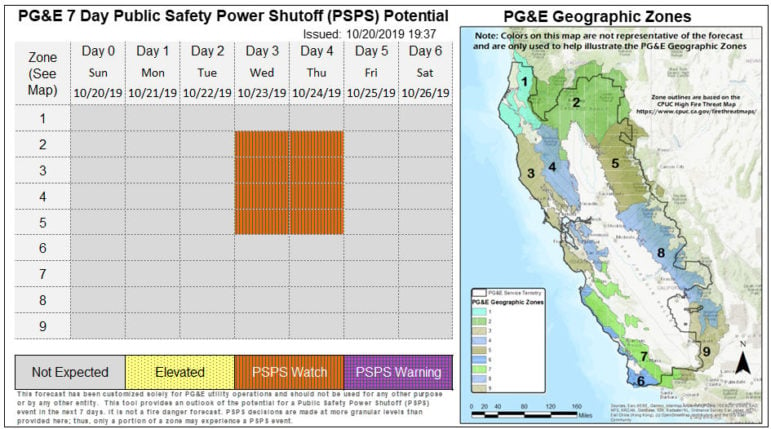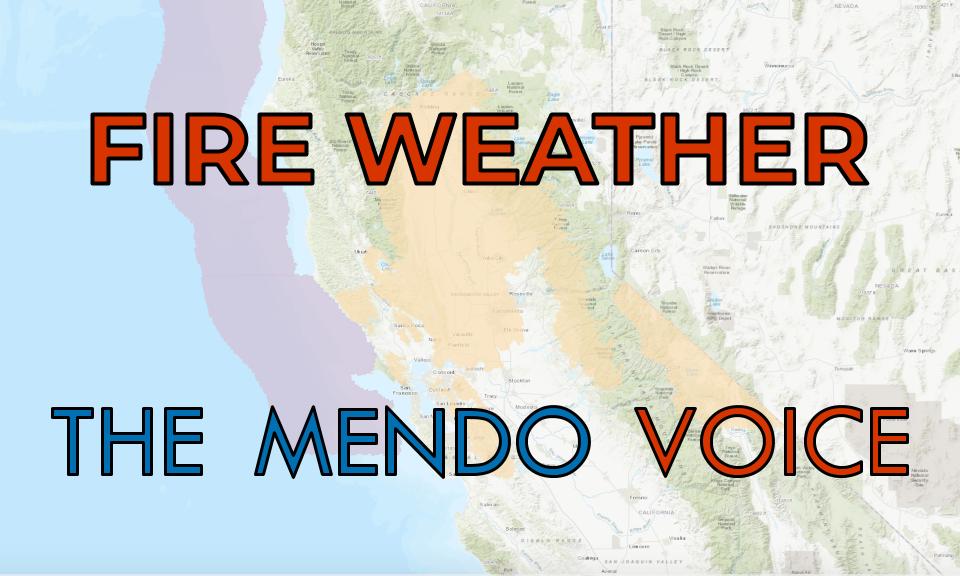UPDATE 10/21/19 — Here’s our latest for today:
ORIGINAL
MENDOCINO Co., 10/20/10 — With elevated fire weather conditions in the forecast for the middle of this week Pacific Gas & Electric has raised its appraisal of the potential for a preemptive power shut-off from merely “elevated,” to an official “watch,” and has opened an “emergency operations center” to monitor the situation.
The utility company has stated in a press release that their meteorologists do not expect this wind event to be as severe as the one two weeks ago that left nearly 2 million Californians without power, saying, “This potential event, if initiated, is expected to be significantly smaller in terms of scope and impact than the Oct. 9-12 PSPS event.” A “public safety power shut-off” (PSPS) is the term that PG&E uses for these planned power outages.
But the truth is that the severity of this possible outage remains unknown the wind event remains unknowable — the weather event is three days away, and could be bigger or much smaller than expected. What’s more, the exact method by which PG&E decides to shut down the power is unknown, and apparently comes down to a decision made by three senior company officials, as reported in this story from the San Francisco Chronicle.
Here is PG&E’s chart of the risk of a power shut-off, showing a “PSPS watch” in Mendocino, Sonoma, Lake, and Napa counties for Wednesday and Thursday of this week. This was upgraded to a “watch” from merely “elevated” late tonight. Also late tonight, PG&E issued a press release describing the risk, which can be read below.

In a brief conversation on the phone a meteorologist for the National Weather Service in Eureka explained that while much of the North Bay and Lake County will be experiencing the high winds, higher temperatures and low humidity that characterize fire weather, Mendocino County will largely not have this kind of weather, except in the extreme southeast corner, near Hopland.
This, however, does not mean that we are not at risk of having the power shut-off. The pattern that we saw a couple weeks ago is worth remembering: there was little fire risk in most of Mendocino County, even areas where the power was shut off had relatively high humidity and low winds. But because areas adjacent to the county were experiencing much more severe weather, PG&E decided to shut off the power there — and because of the way that the grid is tied together, this meant that ares effectively “downstream,” in Mendocino, wound up losing power too. The result was balmy, cool, still nights with the power shut off.
Here is an excellent run down of the expected weather patterns for the week from Rob Mayeda at NBC Bay Area:
Here are some tweets from the National Weather Service describing the upcoming weather:
And here is the press release from PG&E:
PG&E is Monitoring a Severe Wind Event Later this Week That Could Impact Portions of 17 Counties Across Northern and Central California
PG&E’s Emergency Operations Center is Open and Actively Monitoring the Situation
SAN FRANCISCO, Calif. — Pacific Gas and Electric Company activated its Emergency Operations Center at 6 p.m. Sunday night to monitor a potentially strong and dry offshore wind event Wednesday and Thursday of this week. PG&E’s meteorological and operations teams continue to actively monitor the weather system that could impact portions of the Sierra Foothills and the North Bay.
Due to the forecasted extreme weather conditions and dry fuels, PG&E is considering proactively turning off power for safety, and implementing a Public Safety Power Shutoff, across portions of 17 Sierra Foothills and North Bay counties. At this time, no PSPS has been called, and PG&E will provide updates several times a day.
Portions of counties that may be impacted include, but are not limited to: Amador, Butte, Colusa, El Dorado, Lake, Marin, Mendocino, Napa, Nevada, Placer, Plumas, San Joaquin, Solano, Sonoma, Tehama, Yolo and Yuba. This potential event, if initiated, is expected to be significantly smaller in terms of scope and impact than the Oct. 9-12 PSPS event.
The main period of weather risk is forecast to last about 18 to 24 hours, from Wednesday evening through mid-day Thursday. The dry, windy weather pattern is expected to unfold across the Northern Sierra, Sacramento Valley and the North Bay. The start of the event is more than 72 hours away, and PG&E’s meteorologists will continue to study updated weather forecast models 24/7 over coming days.
PG&E has opened its Emergency Operations Center in San Francisco. The status of PG&E’s 7-Day PSPS Potential Forecast has moved to “PSPS Watch,” indicating that there is a “reasonable chance of executing a PSPS to reduce public safety risk in a given geographic zone due to a combination of adverse weather and dry fuel conditions.”
How Customers Can Prepare
As part of PSPS preparedness efforts, PG&E is asking customers to:
Update your contact information at www.pge.com/mywildfirealerts or by calling 1-866-743-6589 during normal business hours. PG&E will use this information to alert customers through automated calls, texts, and emails, when possible, prior to, and during, a Public Safety Power Shutoff.Plan for medical needs like medications that require refrigeration or devices that need power.
Identify backup charging methods for phones and keep hard copies of emergency numbers.
Build or restock your emergency kit with flashlights, fresh batteries, first aid supplies and cash.
Keep in mind family members who are elderly, younger children and pets. Information and tips including a safety plan checklist are available at pge.com/wildfiresafety.
Learn more about wildfire risk and what to do before, during and after an emergency to keep your family safe at PG&E’s Safety Action Center.
While customers in high fire-threat areas are more likely to be affected by a Public Safety Power Shutoff event, any of PG&E’s more than 5 million electric customers could have their power shut off because the energy system relies on power lines working together to provide electricity across cities, counties and regions.Generator Safety
Backup electric generators can be a part of any preparedness plan, but they can also pose unique safety hazards.
It’s important to understand how to safely operate your generator before an emergency occurs. This means doing regular safety checks and being sure you have enough fuel to last a few days. If you don’t understand how to use your generator, you risk damaging your property, endangering your life and endangering the lives of others.
Position your generator where its exhaust can vent safely to prevent carbon monoxide poisoning, which can be fatal. Never run a portable generator in the garage or in the rain, and never store generator fuel in the house.Additional tips on the safe use of generators can be found at PG&E’s Safety Action Center at www.safetyactioncenter.pge.com.




